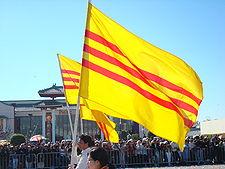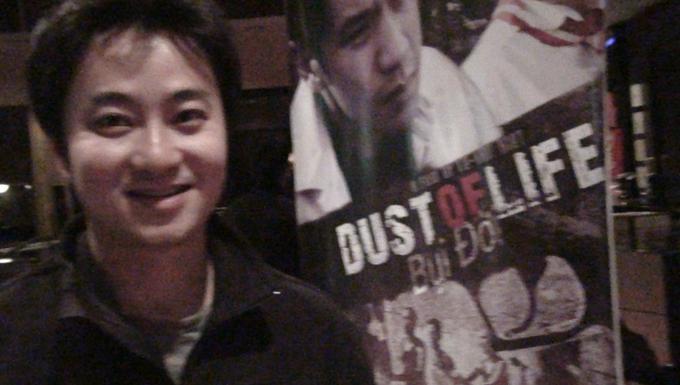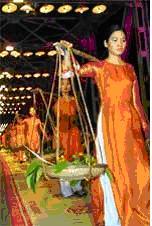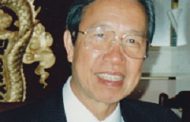 I am working on the forced emigration of the Vietnamese people after the Vietnam War because I want to show you how it impacted the Vietnamese-American community in the United States in order to explain to you the continuing influence of the “migration” story on Vietnamese-American identity. As I worked on the forced emigration of the Vietnamese people the most important thing I found out was that the Vietnamese-American communities were reformed to create a community identity to help better their lives after a horrific event. Now that I know that, I understand better the values of the Vietnamese customs and the issues that prevail within the Vietnamese community. There are common stereotypes that the Vietnamese people tend to isolate themselves in their own community and are reserved in their culture. The issues and reasons that are prevalent in the Vietnamese-American communities also correlate with other ethnic communities; by becoming aware of these views and reasons in a community we can learn how social networking can contribute to American people and society.
I am working on the forced emigration of the Vietnamese people after the Vietnam War because I want to show you how it impacted the Vietnamese-American community in the United States in order to explain to you the continuing influence of the “migration” story on Vietnamese-American identity. As I worked on the forced emigration of the Vietnamese people the most important thing I found out was that the Vietnamese-American communities were reformed to create a community identity to help better their lives after a horrific event. Now that I know that, I understand better the values of the Vietnamese customs and the issues that prevail within the Vietnamese community. There are common stereotypes that the Vietnamese people tend to isolate themselves in their own community and are reserved in their culture. The issues and reasons that are prevalent in the Vietnamese-American communities also correlate with other ethnic communities; by becoming aware of these views and reasons in a community we can learn how social networking can contribute to American people and society.
In the United States, whenever a group of minorities come together the feeling of fear takes place. Society has called these reformed groups of minority ghettos: a section of a city occupied by a minority group who live there especially because of social, economic, or legal pressure. The fear comes from the sense of being threatened; these ghettos might corrupt American society. Therefore the government has to find means to control and sustain sub-minority groups. On both sides of the spectrum, the minorities and the majorities both have a sense of fear, but the difference is the ways they are able to handle their fears. The government or majority have the status to control their fear, where as the minorities have to find ways to face and overcome their fears. The government’s reason of fear and control could be the result of past experiences with ethnic communities. For instance the Italians who were in New York had formed violent groups know as Mafias. The government had to form legal actions and laws to regulate American society.
With the Vietnamese people coming to America in 1975 for the first time, that is exactly what happened. In the year 1980, the Refugee Act was signed into law by Jimmy Carter in which stated a definition of a refugee: It is the historic policy of the United States to admit to this country, refugees of special humanitarian concern, reflecting our core values and our tradition of being a safe haven for the oppressed. The applicant must demonstrate a well-founded fear of persecution on account of race, religion, nationality, membership in a particular social group, or political opinion. It is not enough to demonstrate that the country in which the applicant lives is dominated by a repressive government in which any citizen is potentially subject to violations of civil or human rights. Rather, the applicant must demonstrate that he or she has been singled out for persecution by the government for political, religious or social reasons (U.S. Department of Health and Human Services).
As described in the Refugee Act, there is a huge distinction between an immigrant and a refugee. Most people find confusion between the two terms: “Immigrants choose to come to a new life, whereas refugees are forced to flee – often for their lives” (Freeman 11). Vietnam along with Cuba and the Soviet Union is one of the few countries that the United States operates an in country processing program. The Refugee Act enabled the American government to take in Vietnamese refugees and disperse them across America in Wichita, Detroit, Houston, Atlanta, San Diego, Portland, New Orleans, etc. The point was not to let the Vietnamese people conglomerate in one geographical area because there was a lot of fear that the Vietnamese people would form “ghettos.” With the Refugee Act about 45% of the Vietnamese population relocated to California, Texas, and Louisiana. The Vietnamese people obviously felt a culture shock and fear of coming to an unknown place not knowing what the outcome of the future might hold for them. It is not say the Refugee Act that was impended upon the Vietnamese refugees was bad, but in ways had actually helped the Vietnamese people. My father who was also a Vietnamese refugee at the time expressed that it gave the Vietnamese people a sense of direction. He expressed that it would not matter where we were placed, because everywhere you go it would be strange anyways. All that is wanted at the time was for us not to be separated from out families. Obviously the Vietnamese people did not know at the time that they were under a governmental act because the Vietnamese people were more worried about other issues. Even today many people are oblivious that this act even existed. It goes to show the type of control the government have in sustaining society and people. It changes the common perspective that America is a democratic society, when in actuality everything in this so-called “democratic” country is controlled by the government. The governmental control also extends to on whether or not what is being done should be know to society.
The refugees face what sociologists call a “double crisis.” There is the obvious obstacles shared by both immigrants and refugees is the need to find shelter and work, learn to communicate in a new language, and adjust to drastic changes of environment around them despite the barriers of culture shock, poverty, stereotypes, and whatnot. “In addition, the refugee unlike most immigrants must also come to terms with the losses of the past that include home, country, family, friends, etc. This double challenge is called a high demand, low control situation that fully tests the refugee’s emotional resilience and coping resources and produces severe psychological distress even among the best prepared and even under the most receptive of circumstances” (Freeman 11). In ways the placement of Vietnamese Refugees helped the Vietnamese people because it gave them guidance and direction in a new society, it would not matter where a Vietnamese refugee was placed, everywhere would be strange and new.
However, there was tremendous effort by the Vietnamese people to form a community identity; which are the reasons why Vietnamese communities came about. There are a great number of Vietnamese-American communities that were formed throughout the United States. The main hubs of Vietnamese communities are Westminster, California, the largest Vietnamese community outside of Vietnam, Houston, Texas, and New Orleans, Louisiana. All these Vietnamese communities have the same history and went through and overcame similar obstacles, but each Vietnamese community differs in how the Vietnamese culture is expressed through the American way of life – hence Versailles in New Orleans. Versailles is a large Catholic Vietnamese-American community in which over 7,000 Vietnamese people reside. What sets Versailles apart from other Vietnamese communities is its location in the suburbs of New Orleans where a lot of the Vietnamese traditional values are kept, even the homeland atmosphere:
When beholding a glimpse of Versailles, one feels as if one is transported back to Viet Nam – seeing backyards of homes where the Vietnamese-Americans have planted a community garden stretching down the lagoon; witnessing the backyards plowed and planted as if it were some quiet countryside village in Viet Nam; watching a scattering of people outside donning straw conical hats as they cultivate their gardens with care. It has grown immensely through the years to include many thriving Vietnamese owned and operated businesses. On the weekends, the community operates an open market that resembles an image you can find in Vietnam – at first, only vegetables were sold, but now they sell all sorts of edibles and goods. One interesting component of this “little Saigon” market is that the vendors are not just Vietnamese; they include other local American vendors as well. Because many of the Vietnamese-Americans have ventured into different branches of businesses (i.e. operating supermarkets, constructing houses), many streets have been changed to Vietnamese names such as Saigon, Tu Do, and Viet My (Tran 111-112).
Versailles is an example of a successful Vietnamese community; it is integration into the American culture. Integration is the act of incorporating any racial or religious group in to a community whereas assimilation is a total immersion into one culture. The description of Versailles was a result of the endeavor of the Vietnamese refugees coming together. The Vietnamese refugees had to pass through many trial and tribulations to find their voice and stance in America.
The biggest obstacle that was faced by the Vietnamese community happened during the early 1980s known as the fisherman conflict. Like most immigrants or refugees coming to America they sought to find jobs to make ends meet. In New Orleans fishing is a huge commodity and this was a benefit to the Vietnamese people since most of them were skilled fishermen in Vietnam. The New Orleans fishing industry was quickly filled up with Vietnamese workers. The conflict arose when the fishing community accused the Vietnamese people of violating the maritime regulation laws. From this incident animosity towards the Vietnamese community heightened and resulted in public threats and sabotage of Vietnamese property. With the Vietnamese poor grasp of the English language at the, they had difficulty communicating with the American people to show that it was unintentional. Although the Vietnamese community was faced with the language barrier, the Vietnamese community wanted to find ways to resolve the issues. They sought to seek help outside their community and had to work with the American community. There is the adage “no pain no gain,” which holds a lot a truth. With the hard work of integration in Versailles, there are hopes that it can motivate other Vietnamese communities to also strive for the same view. Not every Vietnamese-American community has the success of integrating the Vietnamese culture.
In Portland, OR there is a Vietnamese-American community, more specifically the Vietnamese Catholic community called the Southeast Asian Vicariate located in Southeast Portland. The Southeast Asian Vicariate is quite small compared to Versailles, but is the second largest ethnic community in Portland alone (Hispanics is the largest). The Portland Vietnamese community has successfully differentiated themselves as Vietnamese-Americans, but that have not fully integrated their community into Portland. It is one thing to form and distinguish an ethnic community, but real integration takes place when working with the American society. The Portland Vietnamese-American community is at a few disadvantages in expressing their culture. The American people that reside around the Vietnamese community are oblivious to the Vietnamese culture and sometimes seem to have misunderstanding in some parts of the Vietnamese culture. An example of one of the many incidents is during a Moon Festival that was held at the Vicariate; a festival celebrated by Vietnamese people. A pleasurable event resulted in lot complaints of loud noise disturbing the neighborhood. The Portland Vietnamese community has yet to find their own voice and work with the American community to help make clear of any misconceptions. “The Vietnamese communities everywhere ought to be more united, respect and tolerate others views, and accept the differences – learn to build out strength on these” (Long 37). It is one thing to maintain a cultural identity and a sense of community, but it is another matter to be isolated. An attempt to get people outside the Vietnamese community to gain an understanding of the culture is not an easy task, but an effort will most definitely decrease the misconceptions.
The first priority of most Vietnamese upon arrival in a new country is to get through hard times, which is palpable through the many Vietnamese migration stories. The reasons for the Vietnamese people to come together were for survival in a new country to find a sense of security and comfort. This was a group of people that has faced a fatal war and was forced to flee a beloved country. It was important for them to live with family members, an important cultural identity, since they had lost and left a significant number of family members in Vietnam. It is natural human instincts to be with people who acquire the same attributes between two individuals, whether it is race, ethnicity, or religion. In the Vietnamese refugee’s case, they needed to be surrounded with people who understood their obstacles, culture, and language, and so forth. Usually when a group of minorities who feel alienated from society will resort to forming their own groups with their own rules; in which sociologists call domestic networks: “A group of culturally similar people immersed in a domestic web of a large number of kin and friends whom they can count on. From a social viewpoint, relationships within the community are organized on the model of kin relationships. Kin constructs such as the perception of parenthood, the culturally determined criteria which affect the shape of personal kindred, and the idiom of kinship, prescribe kin who can be recruited into domestic networks” (Stack 361). In the Vietnamese culture no one lived on an individual basis, everyone lived for each other; that is why a social community of family and friends is an important factor. The Vietnamese needed cultural support to sustain them. The Vietnamese community did not depend on the system for aid, but instead relied on the support social networks around them.
 It is through this social network of support and working with one another that the Vietnamese people were able to find a progression of the Vietnamese community in American society. It has been a little over 25 years since the first group of Vietnamese refugees set foot on America. Over time a lot evolution took place within the Vietnamese community. America offers many opportunities and freedom that was not granted to them in Vietnam, therefore many of the Vietnamese families took advantage of these offerings to better their lives for the next generation after them. Now the American society as well as the Vietnamese community is recognizing the roles of Vietnamese-Americans in America. In 2000 a group of young second-generation Vietnamese-Americans established a community to pay tribute to the Vietnamese-American community with the development of a publication called “New Horizon” to honor the 25 years of the Vietnamese’s presence in America. The publication gives biographical information on successful Vietnamese-Americans who have become doctors, film-makers, astronauts, football player, artists, etc. The Vietnamese-Americans presented in the publication achieved the common ideology of the American Dream. These people were able to rise up in mobility and status despite the hardships of coming from a background of being a refugee and a minority. Living up to the American dream is successful, but what is progress to the Vietnamese-American community is integration not assimilation. What makes a Vietnamese-American successful is finding a connection with their ethnicity and culture as well as the American culture. Language plays an extremely important factor when forming a connection to an ethnicity. Culture is a shared set of values, beliefs, expectations, and artifacts that encompass the way people live and culture can be similar from one country to another. It is safe to say the language is more vital than culture because language is what sets each country apart and makes it unique. Each language is different from one another; language is what defines an ethnicity. It does not matter how Americanized a Vietnamese-American is, if the language is still enacted, then the connection is still there.
It is through this social network of support and working with one another that the Vietnamese people were able to find a progression of the Vietnamese community in American society. It has been a little over 25 years since the first group of Vietnamese refugees set foot on America. Over time a lot evolution took place within the Vietnamese community. America offers many opportunities and freedom that was not granted to them in Vietnam, therefore many of the Vietnamese families took advantage of these offerings to better their lives for the next generation after them. Now the American society as well as the Vietnamese community is recognizing the roles of Vietnamese-Americans in America. In 2000 a group of young second-generation Vietnamese-Americans established a community to pay tribute to the Vietnamese-American community with the development of a publication called “New Horizon” to honor the 25 years of the Vietnamese’s presence in America. The publication gives biographical information on successful Vietnamese-Americans who have become doctors, film-makers, astronauts, football player, artists, etc. The Vietnamese-Americans presented in the publication achieved the common ideology of the American Dream. These people were able to rise up in mobility and status despite the hardships of coming from a background of being a refugee and a minority. Living up to the American dream is successful, but what is progress to the Vietnamese-American community is integration not assimilation. What makes a Vietnamese-American successful is finding a connection with their ethnicity and culture as well as the American culture. Language plays an extremely important factor when forming a connection to an ethnicity. Culture is a shared set of values, beliefs, expectations, and artifacts that encompass the way people live and culture can be similar from one country to another. It is safe to say the language is more vital than culture because language is what sets each country apart and makes it unique. Each language is different from one another; language is what defines an ethnicity. It does not matter how Americanized a Vietnamese-American is, if the language is still enacted, then the connection is still there.
Despite the many successes and the progress in the Vietnamese-American communities, many issues and obstacles are faced by Vietnamese people everyday. Living up to the expectations of the Vietnamese-American’s ideal as well as the American dream is easier said than done. This is a very difficult task for both generations. Living in America, the lives of the Vietnamese people are forever changed. The Vietnamese people have to deal with the misconceptions of their culture and community from American society:
The one most difficult problem is the American law, and the American way to educate children. This is a big obstacle for the Vietnamese family. In Vietnam, in education our children, if we cannot get success telling them what to do, we would punish them with a beating. By doing so, they would become good people. Here we cannot beat the children. That’s the reason there’s a big obstacle for us (Freeman 387).
This is one of the many examples many Vietnamese families face. To Americans this act of obedience is seen as demeaning and is not tolerated. Because of the views of American towards this kind of act, many Vietnamese families have abandoned this type of conformity. This situation turns out to be especially hard because in the Vietnamese culture, the parents do not converse with their children as opposed to American society where it is encouraged. Obviously the Vietnamese-Americans are not knowledgeable in any other forms of raising their children other than what is usually done in the Vietnamese culture. The Vietnamese parents face a fear of their children not keeping their true values and becoming an appalling person. It is hard enough to deal with the issues outside of the community, but there greater issues that are faced inside the Vietnamese community. It is hard for first generation Vietnamese to survive outside the communities with cultural and language barriers, but what is more of a challenge is upholding the Vietnamese traditional values and transcending them to the next generation while being surrounded by American society. Many second generations have already started to assimilate to the American culture, and so there is the concern for the third generation and so forth. There is a fear that the Vietnamese culture could be gradually lost. In most cases the issue of cultural gap is what most Vietnamese teenagers go through. When two culturally adapted minds come together, the views tend to clash together causing conflict. The generation gap will always be prevalent, but there needs to be a mutual respect and it comes from accepting and respecting one another’s views and perspectives. Addressing the task is easy, but taking it to action is a lot harder, but if an effort is made it could be a work in progress. Another issue that lies within the Vietnamese-American communities is stereotypes. Obviously there are stereotypes towards the Vietnamese by Americans, but the larger issue at the moment is the Vietnamese community forming their own stereotypes with their own ethnicity. The Vietnamese people have developed terms to differentiate the different “types” of Vietnamese. The fist stereotypical term used to describe the Vietnamese people was “boat people” referring to their escape with the transportation of boats or vessels. “Boat People” have transcended into other terms such as Fobs, F.O.B. (Fresh off the Boat) with the intentional meaning of labeling any Vietnamese who have just came to America. There are American-born Vietnamese who have assimilated into the American culture are referred to as “Twinkies” or “bananas” with the definition of yellow on the outside white on the inside, and gooks, VC (Viet Cong), and so on. There isn’t any credibility as to where and the reasons why these stereotypical terms came about. The focus is that these stereotypes have form prejudices and a division between the Vietnamese people; Fobs do not interact with the “Twinkies” and vice versa. These stereotypical labeling is the starting point of forming resentfulness between the Vietnamese people; even to the result of violence. The Vietnamese community, already a sub-culture in America, has their own sub communities in their own community – thus emerged “Asian gangs.” The Vietnamese and American community has recognized this resentment as an issue. The “Asian gang,” which was labeled by society, was sprung into media. From that point, even more stereotypes were formed. People outside the Vietnamese community started to view the Vietnamese community as deviant and atrocious. Of course not all Vietnamese people account for the conflict of the “Asian gang” but because of the media’s portrayal, it has formed the mindset that Vietnamese people are bad. The issues that were discussed are only a fraction of what the Vietnamese community face daily. In order to help make their community better, the Vietnamese people created programs to help the community. For example there are Vietnamese language classes that are usually supported through religious affiliation to help American-born Vietnamese find a connection to their own ethnicity. On the contrary there are programs such as English Second Language (ESL) that helps ethnic immigrants, including Vietnamese people, to English. Evidently some issues did progress overtime, but the issues within and outside the Vietnamese community will always be prevalent. There is always going to struggles in means to meet the ideal goal of the Vietnamese-American. It is only a matter of recognizing the issues.
 The types of issues that are prevalent within the Vietnamese-American community also correlate with other ethnic communities as well. The United States is a home to many ethnicities, in which America has been described as a “melting pot.” The topic of Vietnamese-American is an important issue to discuss not only for people of Vietnamese descent, but also for those who are not Vietnamese. The Vietnam War is a part of American history, and with the Vietnamese people living in America it is a reminder to both about the tragic. There is a common ground. We have to keep in mind that the Vietnamese people were forced to flee not by their own means. For most Vietnamese people, they long to go back to their homeland, but situations do not permit them to do so. By being aware of this, we can clarify the question as to why the Vietnamese people are in America. By becoming aware of the issues and reason within an ethnic community we can begin to see a clear picture that ethnic communities do in fact contribute to American society, which is through social networking. We need to make clear of any stereotypes and misunderstanding that are usually placed on ethnic communities. Instead, we can see the ethnic communities as something we can gain from. It is truly amazing how a group of people coming to the United States with nothing but hopes and sorrows are able to find a place in society. In America society encourages and values independence, but as a replacement communities should be more valued and encouraged. It is through the Vietnamese-American communities as well as other ethnic communities where we can physically see how strong and powerful a community really is. Maybe we can use this form social networking to bring about positive change within our American society.
The types of issues that are prevalent within the Vietnamese-American community also correlate with other ethnic communities as well. The United States is a home to many ethnicities, in which America has been described as a “melting pot.” The topic of Vietnamese-American is an important issue to discuss not only for people of Vietnamese descent, but also for those who are not Vietnamese. The Vietnam War is a part of American history, and with the Vietnamese people living in America it is a reminder to both about the tragic. There is a common ground. We have to keep in mind that the Vietnamese people were forced to flee not by their own means. For most Vietnamese people, they long to go back to their homeland, but situations do not permit them to do so. By being aware of this, we can clarify the question as to why the Vietnamese people are in America. By becoming aware of the issues and reason within an ethnic community we can begin to see a clear picture that ethnic communities do in fact contribute to American society, which is through social networking. We need to make clear of any stereotypes and misunderstanding that are usually placed on ethnic communities. Instead, we can see the ethnic communities as something we can gain from. It is truly amazing how a group of people coming to the United States with nothing but hopes and sorrows are able to find a place in society. In America society encourages and values independence, but as a replacement communities should be more valued and encouraged. It is through the Vietnamese-American communities as well as other ethnic communities where we can physically see how strong and powerful a community really is. Maybe we can use this form social networking to bring about positive change within our American society.
Hoa Nguyen










































